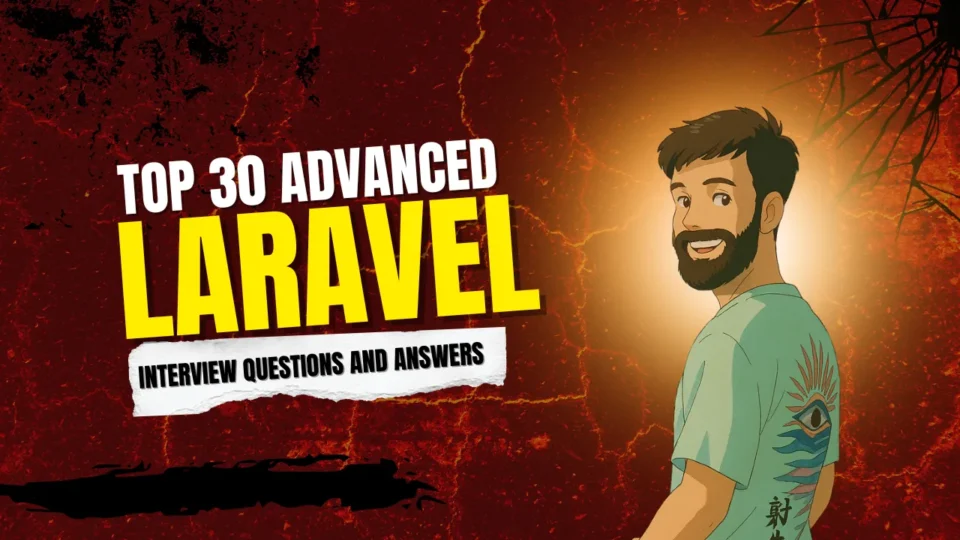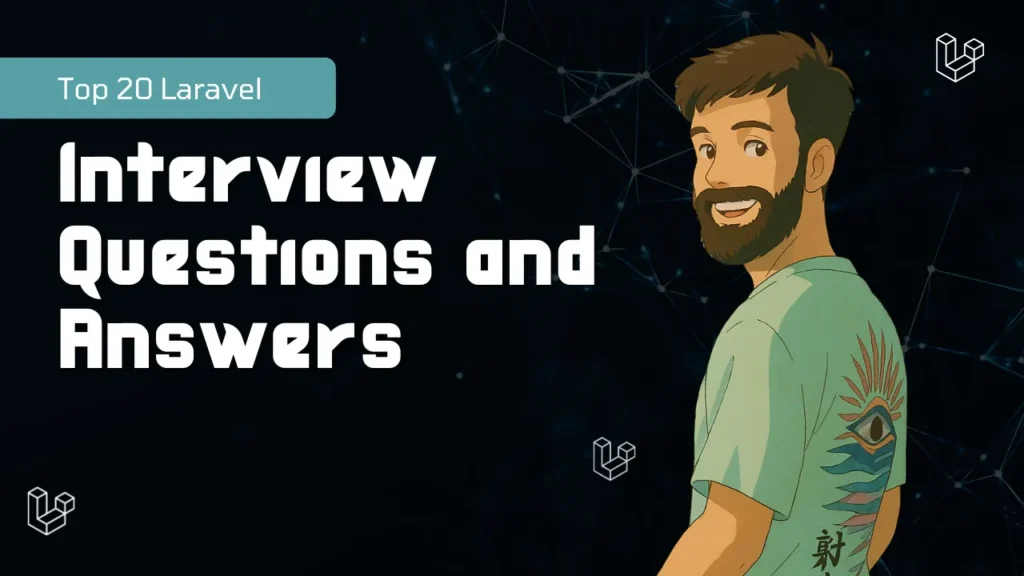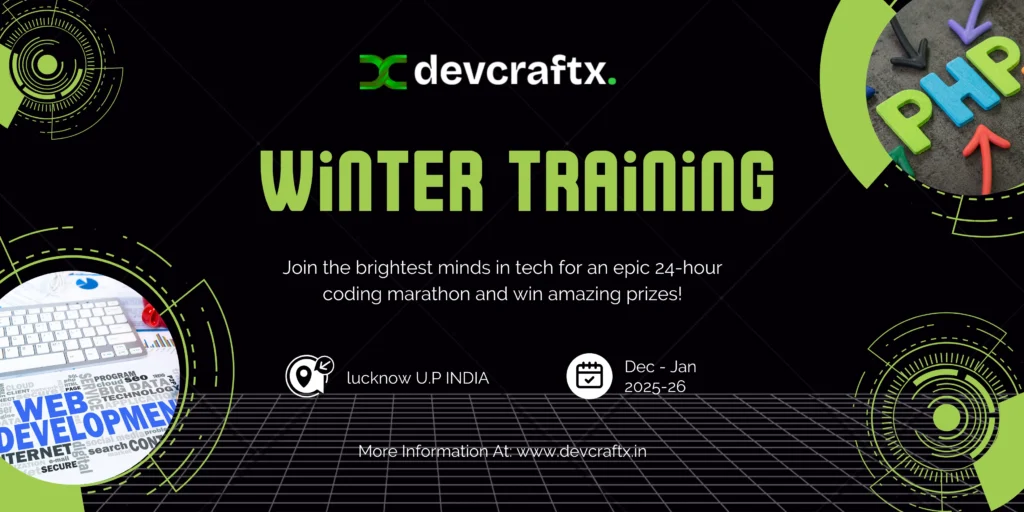Here are the Top 30 Advanced Laravel Interview Questions and Answers (2025 Updated) for experienced developers:
1. What are Laravel service providers?
Answer: Service providers are the central place of all Laravel application bootstrapping. They bind services into the service container and configure necessary services for the app.
2. What is Laravel’s Service Container?
Answer: It’s a powerful dependency injection container used for binding and resolving classes and interfaces. It facilitates automatic dependency resolution.
3. Explain Laravel Facades.
Answer: Facades provide a “static” interface to classes available in the service container. They’re syntactic sugar for accessing services behind the scenes.
4. What is Middleware in Laravel?
Answer: Middleware filters HTTP requests entering your application. For example, auth middleware checks if the user is authenticated.
5. How does Laravel handle CSRF protection?
Answer: Laravel automatically generates a CSRF token for each active user session and verifies the token on POST, PUT, PATCH, or DELETE requests.
6. What are Laravel Events and Listeners?
Answer: Events allow you to subscribe and listen for events in your application, promoting loose coupling. Listeners handle the logic once an event is fired.
Top 30 Advanced Laravel Interview Questions and Answers
7. What is the Repository Pattern in Laravel?
Answer: It’s a design pattern that decouples the business logic from data access logic by providing an interface for data retrieval.
8. What is Laravel Nova?
Answer: Nova is a premium admin panel for Laravel applications. It provides an elegant interface for CRUD operations and managing Eloquent models.
9. What is the difference between hasOne and belongsTo in Eloquent?
Answer:
hasOne: A model owns another model.belongsTo: A model is owned by another model.
10. How does Laravel’s queue system work?
Answer: Laravel supports background job processing via queues. It uses drivers like Redis, Beanstalkd, or database to queue jobs.
11. How do you create and register custom Artisan commands?
Answer: Use php artisan make:command, and register the command in Kernel.php. Useful for CLI tasks like data cleanup or sending emails.
12. What are Laravel Gates and Policies?
Answer: Gates and Policies handle authorization logic. Gates are closures, and policies are classes grouped by models.
Top 30 Advanced Laravel Interview Questions and Answers
13. Explain Laravel Broadcasting.
Answer: Broadcasting allows you to share real-time data between the server and client using WebSockets (e.g., Laravel Echo + Pusher).
14. How does Laravel handle API Rate Limiting?
Answer: Laravel provides ThrottleRequests middleware to limit the number of API requests per minute per user/IP.
15. What is the difference between Resource, Collection, and ResourceCollection?
Answer:
Resource: Represents a single model transformation.Collection: Represents multiple models.ResourceCollection: Custom class for multiple resources with metadata or pagination.
16. How does Laravel handle environment configuration?
Answer: It uses .env files. Values are accessible via env() or config() helper functions.
17. How to use Task Scheduling in Laravel?
Answer: Define scheduled tasks in app/Console/Kernel.php using the schedule() method. Run php artisan schedule:run via a cron job.
18. What is the boot() method in a service provider?
Answer: It is used to perform actions after all services are registered, such as route bindings, observers, or publishing assets.
Top 30 Advanced Laravel Interview Questions and Answers
19. What is Eager Loading and Lazy Loading in Laravel?
Answer:
- Lazy Loading: Fetches related models only when accessed.
- Eager Loading: Fetches related models in advance using
with()to avoid N+1 query problems.
20. How do you handle API Authentication in Laravel?
Answer: Using Laravel Sanctum (lightweight token auth) or Laravel Passport (OAuth2 implementation).
21. What are Mutators and Accessors in Eloquent?
Answer:
- Mutators: Modify attribute before saving to DB.
- Accessors: Modify attribute when retrieving from DB.
22. What is Dependency Injection in Laravel?
Answer: It’s a technique to achieve inversion of control (IoC) by injecting class dependencies directly into constructors or methods.
23. How does Laravel handle soft deletes?
Answer: Models use SoftDeletes trait. Records aren’t removed from the DB but flagged with deleted_at.
24. Explain Laravel’s Job Batching.
Answer: Job batching allows you to dispatch multiple jobs together and track their completion or failures using Bus::batch().
Top 30 Advanced Laravel Interview Questions and Answers
25. How do Laravel Macros work?
Answer: Macros allow you to add custom methods to Laravel’s built-in classes like Collections, Response, etc.
26. What is Laravel Horizon?
Answer: Horizon is a dashboard for monitoring Redis queues, job status, failed jobs, and queue metrics in real-time.
27. How does Laravel handle localization?
Answer: Laravel uses the lang directory and helper methods like __() and @lang to support multilingual applications.
28. How to implement multi-auth in Laravel?
Answer: Configure multiple guards in auth.php, create separate login controllers, and set middleware for each user type.
29. What are Observers in Laravel?
Answer: Observers allow you to hook into Eloquent model events like created, updated, deleted, etc., for model-specific logic.
30. What’s the difference between sync(), attach(), and syncWithoutDetaching() in many-to-many relationships?
Answer:
attach(): Adds a new pivot record.sync(): Replaces existing pivot records.syncWithoutDetaching(): Adds new records without removing existing ones.
Top 30 Advanced Laravel Interview Questions and Answers
Table of Contents
Top 30 Advanced Laravel Interview Questions and Answers




1 comment
[…] Top 30 Advanced Laravel Interview Questions and… […]